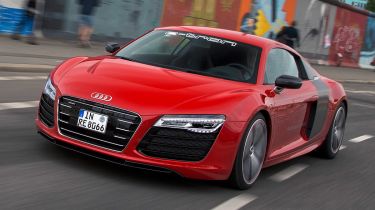Audi R8 e-tron
The electric Audi R8 e-tron won't be built, but its tech will live on in the next-generation model

It’s a shame that the R8 e-tron won’t become a production reality, as the performance it offers is addictive, and the driving experience is every bit as exciting as the petrol model, albeit delivered in a different way. What’s more, its stiffer, lighter carbon-fibre-infused body and e-torque vectoring won’t go to waste – making the prospect of the next generation of R8 even more enticing.
The electric e-tron was supposed to crown the R8 range, but Audi has pulled the plug mere months from its arrival in showrooms. However, 10 near-production cars exist and we’ve driven one to catch a glimpse of what might have been.
There’s a small, silver start button near the gear selector. Once pushed, the car emits a muted, synthesised version of the V10 engine’s purr from four speakers mounted under the car. You can’t hear much noise inside, and the e-tron glides away near-silently on a light throttle.
Our drive took place on a twisty test track. Floor the accelerator and the car’s 820Nm of torque makes amazingly light work of the fact the e-tron weighs 1,780kg - 160kg more than the heaviest V10 model. The noise from the motor sounds like a golf cart on steroids, but the acceleration it delivers is brutal.
Used - available now

2023 Audi
Q4 Sportback e-tron
54,526 milesAutomaticElectric
Cash £23,363
2022 Kia
Niro
18,315 milesAutomaticPetrol1.6L
Cash £17,900
2023 Nissan
Juke
40,858 milesManualPetrol1.0L
Cash £12,287
2022 Volkswagen
T-Roc
36,779 milesAutomaticPetrol1.5L
Cash £18,600You do notice the extra weight when braking, however, although you can increase the amount of power the motors regenerate by pulling the left-hand paddle on the steering wheel. This better helps mimic the effect of engine braking.
The front brakes are a traditional hydraulic set-up, but the rears use a computer-controlled brake-by-wire system. However, most of the rear braking is done by the motors, although the entire braking process is very smooth despite the different systems working together to slow you down.
The e-tron is rear-wheel drive only. But any loss of handling sharpness is countered by the fact that each rear wheel is powered by its own 140kW motor, allowing the e-tron to adopt a stunningly effective torque vectoring system.
Accelerate around a tight bend and the nose tucks in, resisting understeer with almost spooky effect. Audi’s engineers told us that a version of this system can be used in conjunction with a petrol engine.
The ride remains supple too, despite the fact that the e-tron features new CFRP suspension springs, which weigh 40 per cent less than conventional steel ones. And, while the e-tron is a heavy car, the bodyshell now features 23 per cent carbon-fibre, and weighs 23kg less than the 199kg body of the R8 coupe – all of which bodes well for the R8’s replacement.
The e-tron’s 19-inch alloys are wrapped in low-rolling-resistance Continental tyres. The spaces between each wheel spoke feature carbon fibre flaps which close at speeds above 30mph, reducing drag, while there’s a new carbon fibre engine cover and a rear diffuser to replace the normal R8’s twin exhausts. The e-tron also borrows the CFRP bonnet from the LMS race car.
Inside, while the R8’s excellent visibility means it’s actually no more intimidating to drive than a TT – even if these pre-production cars are worth over a million Euros each.
A new touch is the 6.8-inch OLED screen, which replaces the rear-view mirror. The tech is borrowed from Audi’s R18 Le Mans car, and uses a rear-facing camera to give a very sharp picture no matter if the level of light varies.







